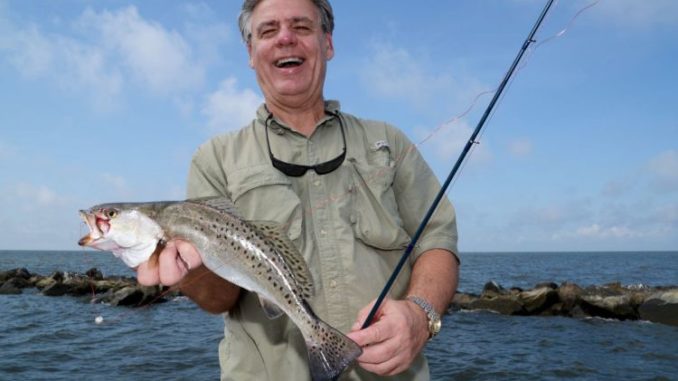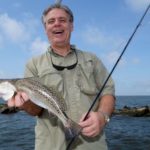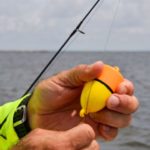
The right gear can mean more specks in high-pressure situations.
“Well, that’s 50 specks,” announced Brian Guidry with his patented Ninth Ward New Orleans accent as he slammed shut the lid of the ice chest.
It was 12:19 p.m., barely after lunch.
Louisiana Department of Wildlife and Fisheries biologists calculate that less than 5 percent of all trips result in speckled trout limits, but Steve Kissee and Brian Guidry acted as if they did it all the time.
I first met the pair when their Versamaxx Coastal Popping Cork booth caught my attention at the annual Louisiana Sportsman Show in Gonzales. I enjoy fishing with popping corks, but every one of them seems to have a drawback.
A little visiting resulted in an invitation to fish for speckled trout with them out of Shell Beach in St. Bernard Parish. Our target would be the rock jetties at the mouth of the Mississippi River Gulf Outlet (MRGO) in Breton Sound.
Just before daylight, Campo’s Marina in Shell Beach was bustling with angler activity — fueling boats and buying live bait. Gravelly-voiced F. J. and his sons Robert and Michael, greeted many of the anglers by name and even treated the ones they didn’t know as friends.
Although the marina is located next to the MRGO, Kissee and Guidry had to make a long detour by the Baker’s Canal Route to avoid the dam that has closed off the MRGO channel. Once back in the big waterway, they headed due southeast to the canal’s outer extremity.
First stop was along the “long rocks” about a half-mile before the “short rocks” ended on the opposite side of the channel. The number of fishing boats along the two walls was unbelievable, a veritable murderer’s row of fiberglass hulls spaced a hundred yards apart, each within casting distance of the wall.
After Guidry eased the anchor down, both men immediately hooked up on the live shrimp under their Versamaxx corks. But the speckled trout were small, most 8 to 11 inches long. They boxed a couple, but at 30 cents apiece for their bait shrimp, they didn’t want to stay long on these cigar trout, even though there were a zillion of them.
They navigated past the gap in the rocks and the new gap to the very end of the rocks. The water was disappointingly dingy. A half-hour later they moved to anchor in the new gap, over where the rock wall once was.
“Even though you don’t see any rocks on the surface,” explained Kissee, “there are still some under the water.” This stop was to no avail as well — no fish. So they moved the boat to the gap in the rocks.
Before deckhand Guidry could get the anchor to bite bottom, Kissee boated a decent 14-incher. Guidry quickly cast to the spot that Kissee caught the fish, but nothing molested the bait.
“Looks like that one was a lone wolf,” grunted Kissee. “Yeah, let’s go,” replied Guidry. They ran back to near where they made their first stop. There were just as many fish there as before, but they were bigger this time.
The two pals were a study in contracts. Kissee had fierce focus while fishing and hardly spoke while he was fishing. Guidry was easy-going and expansive.
They fished identically. Each used a kahle hook, hooked beneath the horn on top of the shrimp’s head.
Their Versamaxx corks were set 3 feet above their hooks and were secured by wrapping the line eight times around the eyelet on top of the cork and eight times around the eyelet on the cork’s bottom.
The cork could easily be moved up or down the line by unwrapping the line. Guidry chose to use an oval cork, while Kissee used the original model with the flat top.
It seemed that any cast to the sweet spot near, but not into the rocks, produced a strike. They fished their corks with gentle pops, doing more to make noise than to retrieve their lines.
The bite steadily picked up until it became ferocious. Kissee pulled ahead early, than Guidry surged to catch up. The trout got bigger too — very few 14-inchers and lots up to 2 pounds.
The guys got competitive. “You got to throw that back; it’s too small,” needled Kissee about Guidry’s pound-and-a-half trout. Guidry just smirked at him while he boxed it.
When the bite shifted to Guidry’s end of the boat, he deliberately fenced Kissee out of the best strike zone.
Kissee shook his head, looked my way and said, “it’s not too competitive with just the two of us in the boat. I usually just catch more than him.”
Guidry groaned. “I come out here to have fun. Kissee is too serious. For him, it’s like a job sometimes.
“You ought to see it when his brother comes in from Dallas. He’s very competitive — biggest fish, most fish, position in the boat.”
“He is very competitive,” admitted Kissee ruefully, further confessing that he himself is a “Type-A fisherman.”
“He’s the easiest going guy around — until it comes to fishing,” laughed Guidry.
Deep in the bite, the pair racked up several turbo sheepshead. “Oh yes,” cooed Kissee. “These rocks are good for sheepshead too. We’ve won many tournaments with sheepshead from here. We have the trophies to prove it.”
Too soon, they had to quit — limited out. The final tally was 50 speckled trout, 2 redfish, and 3 sheepshead.
They paused for a moment before beginning to clean their slimed and bloody boat. It had been a slaughter!



